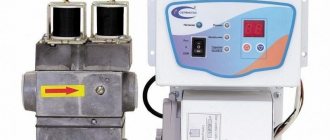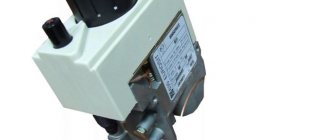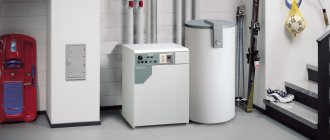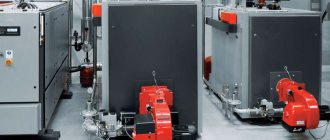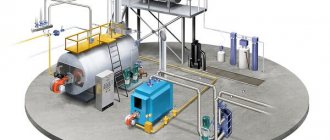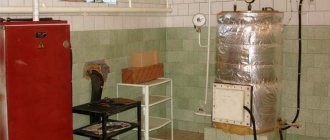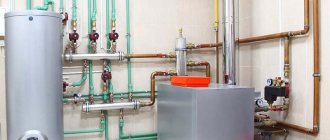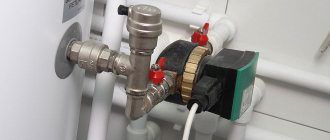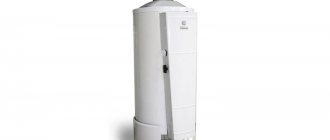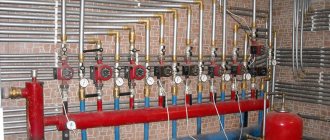General structure
Boiler room automation is built on a two-level control scheme. The lower (field) level includes local automation devices based on programmable microcontrollers that implement technical protection and blocking, adjustment and change of parameters, and primary converters of physical quantities. This also includes equipment designed for converting, encoding and transmitting information data.
The upper level can be presented in the form of a graphic terminal built into the control cabinet or an automated operator workstation based on a personal computer. All information coming from lower-level microcontrollers and system sensors is displayed here, and operational commands, adjustments and settings are entered. In addition to process dispatching, the tasks of optimizing modes, diagnosing technical condition, analyzing economic indicators, archiving and storing data are solved. If necessary, information is transferred to the general enterprise management system (MRP/ERP) or locality.
Automatic boiler safety and regulation
Automation kit ABU-1 for training fire-tube boiler of the “Turboterm” type
Pump control cabinet
Touch panel for indicating the operating parameters of a fire-tube boiler of the “Turboterm” type
Frequency control cabinet for boiler room network pumps
Control panel and emergency interlocks of a fire-tube boiler of the “Turboterm” type
“Frivolous people don’t even stay in the toilets for long.” Gennady Malkin
By subscribing to the Set of Training and Methodological Materials for the Boiler House Operator, in the future you will receive both free and paid information materials from me.
TOR ON THE TOPIC "AUTOMATIC BOILER SAFETY AND REGULATION"
Test “Automation of boiler safety and regulation” to test the knowledge of gas boiler room operators. The main element of the boiler safety automation circuit is the gas shut-off valve. Urgently check your professional competence and demand on the labor market!
KNOWLEDGE TEST QUESTIONS
1. Choose the correct answer from the options provided.
The gas shut-off valve in the automatic safety circuit of a hot water boiler is used for:
a) regulating the gas pressure entering the boiler;
b) regulating the gas flow to the boiler;
c) automatic shutdown of gas supply to the boiler if any parameter involved in the boiler safety automatic circuit is exceeded.
2. Choose the correct answer from the options provided.
Delay in response of the gas shut-off valve in the automatic safety circuit for reducing the air pressure in front of the burner:
a) is allowed and this must be reflected in the Production Instructions; b) is not allowed.
3. Choose the correct answer from the options provided.
Common sensors in safety and control automation circuits are as follows:
a) only a sensor for water temperature after the boiler; b) sensor for water temperature after the boiler and sensors for gas and air pressure in front of the burner; c) there are no common sensors for automatic safety and automatic boiler control circuits.
4. Choose the correct answer from the options provided.
A technical pressure gauge measures pressure:
a) atmospheric; b) excessive; c) absolute; d) vacuum gauge.
5. Choose the correct answer from the options provided.
Checking the serviceability of the pressure gauge is carried out:
a) every shift, by setting the pressure gauge to zero, by the boiler room operator; b) once every six months by the instrumentation and automation service; c) once a year by the State Trustee.
Liquid pressure gauges
6. Choose the correct answer from the options provided.
The accuracy of measuring pressure with a liquid manometer is higher than: (P is the measured pressure; h is the difference in liquid levels; h1 is the change in the liquid level in the tube; h2 is the change in the liquid level in the vessel).
a) U-shaped pressure gauge; b) cup; c) micromanometer.
7. Choose the correct answer from the options provided.
Delay in response of the gas shut-off valve in the automatic safety circuit for extinguishing the burner torch:
a) is allowed and this must be reflected in the Production Instructions; b) is not allowed.
8. Choose the correct answer from the options provided.
Operation of a hot water gas boiler with a faulty automatic control system:
a) not allowed; b) allowed.
9.
Choose the correct answer from the options provided.
With this position of the three-way tap of the pressure gauge:
Boiler pressure gauge with three-way valve
a) purging the siphon tube; b) checking the working pressure gauge against the control pressure gauge; c) measurement of working pressure; d) checking the pressure gauge by setting it to zero; e) accumulation of condensate in the siphon tube (if steam parameters are measured).
TEST QUESTIONS TO ASSESS ABILITIES AND SKILLS
10. Add.
Automatic control of hot water boilers includes:
Dear friend! You will find the answers to this test in the Set of test tasks for the boiler room operator or in the Boiler Room Operator Training Manual. These information materials are paid. It is advisable to have them in your personal library. Questions and recommendations can be left on the Contacts page of the website. See you in touch!
Automatic control of hot water boilers
Safety automation for hot water boilers provides the ability to manually stop the boiler by pressing a certain button. Changes in parameters during system operation are carried out by the following sensors: (See also: Gas-fired water heating boilers)
- An electric pressure gauge changes the fuel pressure in the pipeline;
- Resistance thermometer (RTM) – increase in water temperature;
- Differential pressure gauge – reducing water consumption;
- With a control electrode or photoresistance FSK – flame extinguishing in the burners;
- DT draft sensor - drop in vacuum in the furnace.
Tasks and goals
Modern boiler room automation systems are able to guarantee trouble-free and efficient operation of equipment without direct operator intervention. Human functions are reduced to online monitoring of the performance and parameters of the entire complex of devices. Boiler room automation solves the following problems:
- Automatic start and stop of boiler units.
- Regulation of boiler power (cascade control) according to the specified initial settings.
- Control of feed pumps, monitoring of coolant levels in the working and consumer circuits.
- Emergency stop and activation of signaling devices if the system operating values exceed the established limits.
Automation for boiler rooms and heating systems. Savings, Comfort, Full control.
Individual heating systems perform a complex of complexly regulated processes. To coordinate these processes, control automation with various sets of functions is used. A correctly selected automation kit will allow you to maximally automate the control of your home’s life support systems and ensure minimal fuel consumption (saving up to 25%).
Based on their control functions, automation can be divided into 3 types:
1) Basic automation - contains a minimum set of functions that provide the necessary and sufficient level of control and safety, as well as the possibility of simple regulation. A modern boiler will not work without this automation, so some manufacturers sell equipment with a pre-installed basic control unit. These are companies such as STS (Sweden) or Saint Roch (Belgium), as well as a number of other manufacturers. For German manufacturers of boiler equipment, basic automation, as a rule, is not included in the boiler package and costs some money.
Basic level automation ensures the specified coolant temperature and protects the system from overheating. It is reliable, easy to use, and low cost. However, the control function in this automation is carried out using manual control, which is not very convenient. The coolant temperature is set directly on the boiler control panel, and temperature conditions in individual rooms are ensured by regulating special thermal heads installed on heating devices.
To implement comfortable centralized automated control of heating systems, there are automatic weather-dependent and remote control systems.
2) Weather-dependent automation - ensures the maintenance of specified temperature conditions in the premises by adjusting the temperature of the heated coolant depending on changes in the outside temperature. This regulation allows you to significantly reduce fuel consumption by controlling the energy consumption of the boiler.
The weather-dependent control system is carried out by installing an automation control unit (controller). Here you can implement many complex control functions such as automatic control of multi-circuit heating systems, ensuring the desired temperature in the rooms, support for anti-freeze mode, weather-dependent compensation, etc.
The system is controlled using separately installed sensors connected to the control unit. Room sensors allow you to maintain the temperature set in the rooms, and also provide the ability to switch different temperature modes, depending on the period of time (for example, weekend mode: Monday to Friday +5˚C, Saturday-Sunday +22˚C). The street sensor allows you to minimize fuel consumption due to weather-dependent compensation. This is done by selecting the optimal boiler mode depending on these temperature curves preset in the controller, which significantly reduces the cost of operation.
3) Remote control system - allows you to control and regulate the heating system remotely. The function is implemented by connecting a remote control module (modem) to the automation control unit. Management and control is provided using a computer and/or mobile phone.
Weather-compensated automation with remote control function provides the most comfortable control of the system. You have the opportunity to remotely regulate the temperature in the house and configure the heating system according to your wishes. If the heating system operates in an economical anti-freeze mode (+5..7 ˚С), then you can send a message before arrival, and the boiler will begin to warm the house to the desired temperature. Also, this automation can signal problems in the system, such as a drop in pressure, and you can quickly solve the problem and avoid costly repairs.
By connecting motion sensors and fire alarms to the remote control system, you will reliably protect your home.
Modern automation systems for heating equipment are easy to operate and provide the most economical operation. By choosing control automation from a reliable manufacturer, you get the highest quality, economical and durable equipment with an intuitive interface. Installing automatic control systems can pay for itself within a year of use by reducing fuel consumption costs.
A wide range of selection of various connected functions allows you to create an individual automation kit that is optimal in price and technical characteristics. Our specialists will be happy to select equipment that meets your needs and wishes.
Subsystems and functions
Any boiler room automation scheme includes control, regulation and protection subsystems. Regulation is carried out by maintaining an optimal combustion mode by setting the vacuum in the furnace, primary air flow and coolant parameters (temperature, pressure, flow). The control subsystem displays actual data on the operation of the equipment to the human-machine interface. Protection devices guarantee the prevention of emergency situations in case of violation of normal operating conditions, giving a light or sound signal or stopping boiler units with recording of the cause (on a graphic display, mnemonic diagram, panel).
Safety automation for hot water boilers
Safety automation for hot water boilers involves automation of the combustion process, which is carried out in a special combustion chamber. Fuel and air are supplied to the chamber with a certain dependence on the required parameters of hot water and steam, which in turn are then sent for technological needs.
Along with high-quality regulation of the supply of air and fuel to the combustion chamber, the same process is carried out in the smoke exhauster. This device is necessary to maintain a vacuum in the combustion chamber, as well as in the gas path of the device itself. Thus, a special system designed for automatic combustion control includes special vacuum pressure regulators, as well as a specified ratio of components such as fuel and air.
Automated block-modular gas boiler house
Project Options
The thermal power of the designed boiler house is 5.7 MW. The heating system is single-circuit, closed. The main fuel is natural gas, the backup fuel is diesel fuel. Established volume of natural gas consumption: 2.955 million m3/year, 0.759 thousand m3/hour.
Project Description
Feasibility study: Block-modular gas boiler house, taking into account the change of liquid fuel (fuel oil) to cheaper gaseous fuel (natural gas) with the lowest cost of maintaining a new boiler house. Project composition: 1. Water heating boilers with a total thermal power of 5 MW. The use of 3 imported automated fire-tube hot water boilers with a water heating temperature not higher than 338 K (1150 C) and an efficiency of more than 90%, with the ability to operate in autonomous mode.
2. Gas burner devices. The use of 3 imported automated combined (gas-diesel) burners that ensure safe operation, excluding human intervention, with minimal permissible emissions of pollutants into the environment.
3. Automation system for the safety of the boiler unit in accordance with the requirements of the “Rules for the design and safe operation of steam boilers with a steam pressure of not more than 0.07 MPa (0.7 kgf/cm2) of hot water boilers and water heaters with a water heating temperature not higher than 338 K (1150 C )
4. Pumping equipment of the boiler room with an automatic backup system. The use of imported pumping units with reduced energy consumption and automatic protection of basic operating parameters.
5. Automatic system for regulating boiler room power. The use of weather-dependent automatic control of boiler house power, which has the ability to operate the boiler house according to one of four standard temperature schedules for heat supply.
6. System of make-up and pre-boiler water treatment. The use of imported automated chemical water purification systems operating on the principle of Na-cationization. The use of imported automated systems for chemical purification of water from iron compounds is determined based on the results of the source water. The use of imported automated systems for complex reagent dosing to adjust the quality of the coolant.
7. Coolant flow metering system - the use of commercial gas metering units with telemetry of cold water, thermal energy and hot water flow.
8. Boiler house gas supply system - the use of block gas control points in accordance with the “Safety Rules for Gas Distribution and Gas Consumption Systems” is determined on the basis of the boiler house reconstruction project.
9. Boiler room power supply system - the use of cabinet input distribution devices for power equipment is determined on the basis of the boiler room reconstruction project.
Automation of water heating boiler
The automation of the water heating boiler is manufactured in accordance with the requirements of TU 27.12.31-009-14722122-2017, GOST R 51321.1-2007, GOST 30804.6.4-2013, GOST R 51318.11-2006, PUE, PTEEP, TR TS 020/2011 Technical regulations of customs Union "Electromagnetic compatibility of technical equipment" approved by the decision of the commission dated 09.12.2011 No. 879 and TR CU 004/2011 Technical Regulations of the Customs Union "On the safety of low-voltage equipment" approved by the decision of the commission dated 06.08.2011 No. 768.
Purpose
The water heating boiler automation is designed for installation in three-phase circuits with a grounded neutral with a rated voltage of 380 V, frequency 50 Hz. Manufactured according to climatic design UHL category 4 for operation in a heated room at temperatures from +80C to 400C. The automation of a water heating boiler is designed to prevent an emergency situation during the operation of a water heating boiler using light and sound alarms, as well as manual or automatic control.
Device
The automation of a hot water boiler is a steel case with protective, switching devices and logical modules installed inside, interconnected by wiring; sound or light alarm equipment and control elements are mounted on the outside of the box: buttons, toggle switches, switches. The housing door is locked with a lock. The key to the locks has a single secret. A mounting panel is installed inside the case. On the back wall of the box there are holes for attaching the shield to a vertical wall. Inside the automation, starting and protective switching equipment is mounted on the panel, control buttons and signal lamps are installed on the door.
Contents of delivery. Automation of water heating boiler
The automation package includes:
- Instrumentation and control (as agreed with the customer);
- external supporting elements (as agreed with the customer);
- fasteners (as agreed with the customer);
- housing (box) assembled with protective, switching devices and logical modules interconnected by wiring, sound or light signaling equipment and control elements: buttons, toggle switches, switches;
- passport and instruction manual;
- additional sound or light signaling equipment for external installation (as agreed with the customer);
- additional control elements: buttons, toggle switches, switches for external installation (as agreed with the customer);
- The boards are delivered assembled.
Installation and operation procedure
Installation of boiler automation, startup, adjustment of controlled parameters is carried out in accordance with the instructions in the Certificate and the operating manual for the panel. In the event of emergency situations, operating personnel must act in accordance with the operating instructions for boiler equipment.
Buy automatic water heating boiler
In order to buy an automatic water heating boiler, you can fill out a request at the sales department by calling 8-800-700-06-43, or leave a request online. Our consulting engineers will help you choose a hot water boiler panel model and calculate the cost of delivery to your region and locality.
Automation object
Boiler equipment as an object of regulation is a complex dynamic system with many interconnected input and output parameters. Automation of boiler houses is complicated by the fact that the speed of technological processes in steam units is very high. The main adjustable quantities include:
- coolant flow and pressure (water or steam);
- vacuum in the furnace;
- level in the feed reservoir;
- In recent years, increased environmental requirements have been placed on the quality of the prepared fuel mixture and, as a consequence, on the temperature and composition of smoke removal products.
Automation of boiler equipment
The modern market is widely represented by both individual instruments and devices, and automation kits of domestic and foreign production for steam and hot water boilers. Automation tools include:
- ignition control and flame presence equipment, which starts and controls the fuel combustion process in the combustion chamber of the boiler unit;
- specialized sensors (thrust pressure meters, temperature, pressure sensors, gas analyzers, etc.);
- actuators (solenoid valves, relays, servos, frequency converters);
- control panels for boilers and general boiler equipment (remotes, touch screens);
- switching cabinets, communication lines and power supply.
When choosing technical means of management and control, the closest attention should be paid to safety automation, which eliminates the occurrence of abnormal and emergency situations
Functionality of automatic water heating boilers
In most cases, automation for boilers involves the following functions:
- Automatic ignition;
- Control of the hot water boiler during operation, for example, temperature control and maintenance;
- Keeping records of fuel consumption, which allows you to track fuel costs;
- Automatic shutdown of the hot water boiler in case of an emergency;
- Activation of sound and light alarms;
- Stop the operation of the hot water boiler if necessary.
The range of listed capabilities may vary with respect to the functionality of hot water boilers, each of which must be matched with a specific type of automation. (See also: Manufacturers of gas boilers)
For ease of use of the device, you can purchase a device with a graphic, text, or color display, on which a mnemonic diagram of objects can be displayed. Today, there are many automation modifications on the market regarding these parameters, so buyers have the opportunity to choose the most suitable option for them.
As a rule, boiler automation allows you to regulate the fuel supply using feedback or temporary settings. In addition, the system is equipped with a device that is responsible for interrupting the fuel supply in the event of an emergency, which reduces the risk of an emergency situation and also significantly increases the level of safety of the equipment used.
Automated boiler room
Automated boiler rooms must operate continuously without personnel on duty with a smooth change in the gas supply to the boiler burners, which is signaled by the burning of its light on the panel.
Closely located automated boiler houses are combined into clusters of 5 - 20 boiler houses. Each cluster is served by a control center located in one of the boiler rooms of the given cluster or in a separate room. The automatic alarm system is electrical. The fault signal is transmitted via wires to the remote control located in the control room.
Each automated boiler house must be provided with telephone communication with a cluster control center, for which a channel through which emergency information is automatically transmitted can be used.
In automated boiler rooms, the heating system is replenished with water manually. At the same time, the operation of the boiler room is additionally monitored. If the system is not replenished with water for a long time, the automation turns off the boilers when the level drops below the permissible level.
The start-up of an automated boiler room must begin with checking the documentation for the work performed, including hidden ones, and adjusting gas combustion using proportioning air valves with the main valve turned off.
Maintenance of automated boiler rooms is carried out by the control center staff on duty, who are responsible for all boiler room equipment and the efficiency of its operation.
In fully automated boiler houses operating without permanent maintenance personnel, the fault signal is sent to the control center.
The practice of operating automated boiler rooms controlled from a central control center has shown that its personnel must be perfectly aware of the systems of automatic devices of boiler rooms controlled by this point, the rules for stopping and igniting automated boilers.
Before putting an automated boiler room into operation, the organization that owns the boiler room must submit a certificate of compliance with all the requirements for boiler rooms specified in Chapter.
In conditions of dispatcher service of automated boiler houses, the block principle of constructing an automation circuit has certain advantages. If any of the blocks fails, it can be quickly and easily replaced with a working one.
To ensure trouble-free operation of automated boiler houses, their preventive maintenance is necessary. Preventive maintenance work is carried out in accordance with instructions and schedules regulating the nature, volume and frequency of work performed. Operating instructions for automated boiler rooms must be drawn up in such a way that, through properly organized prevention, the possibility of accidents is virtually eliminated.
The main purpose of a preventive inspection of an automated boiler room is to identify and eliminate implicit failures in the safety automation.
A gas pipeline to remove mechanical impurities must be installed on the gas pipeline supplying the automated boiler room.
To regulate and optimize the functioning of boiler units, technical means began to be used at the initial stages of automation of industry and production. The current level of development in this area can significantly increase the profitability and reliability of boiler equipment, ensure the safety and intellectualization of the work of operating personnel.
Key points when choosing a Unical steam boiler automation system.
The choice of automation is a rather complex task, since its composition depends on the nature of the heat load, the composition of the equipment and the power of the boiler room. The automation composition usually consists of a system of primary sensors, a system for processing and transmitting signals from sensors, a system for processing signals and controlling actuators in accordance with the received signals from primary sensors.
According to its functional purpose, the automation system is divided into a security system and a process control system.
The safety system of the steam boiler must comply with all requirements specified in the factory instructions and in the Federal codes and regulations. The boiler safety system must stop the steam boiler when the operating parameters of emergency values are reached, and before stopping, both an audible and a light signal must be given to the duty personnel about the achievement of one or another parameter of the emergency value. During startup work, the commissioning personnel compiles a list of warning and emergency settings for the operating parameters of the steam boiler and is approved by the operations manager. Checking the operation of the security system consists of three stages:
- at the first stage, an excess (decrease) of the operating parameter is simulated, the command for the actions of the executive body is checked;
- at the second stage, with the boiler running, changing the setting checks the operation of the safety automatics;
- at the third stage, the safety automatics are checked for actual excess (decrease) of the safety automatics.
The automatic control system for a steam boiler must perform an optimal set of functions that is economically justified. If there is only one boiler, then it does not need automation to operate as part of a boiler block; a system for automatically maintaining steam parameters and its consumption within specified limits is necessary.
The automatic control system for a block of steam boilers must perform more complex tasks, in addition to automatically maintaining steam parameters and its consumption, it must monitor the sequence of turning on and off steam boilers to ensure the required load schedule, take into account the operating time of each boiler in order to ensure the same operating time, ensure uniform load distribution between boilers.
The most important task for automatic control of boiler operation is to ensure that the boiler operates at the optimal burner operating mode, i.e. ensure the operation of the burner in accordance with the steam boiler operating schedule.
Adjustment work on automatic control of steam boilers is carried out in accordance with the manufacturer’s factory instructions and Unical software.
Communication protocols
Automation of boiler installations based on microcontrollers minimizes the use of relay switching and control power lines in the functional diagram. To communicate the upper and lower levels of the automated control system, transfer information between sensors and controllers, and broadcast commands to actuators, an industrial network with a specific interface and data transfer protocol is used. The most widely used standards are Modbus and Profibus. They are compatible with the bulk of equipment used to automate heat supply facilities. They are distinguished by high levels of reliability of information transmission, simple and understandable operating principles.
